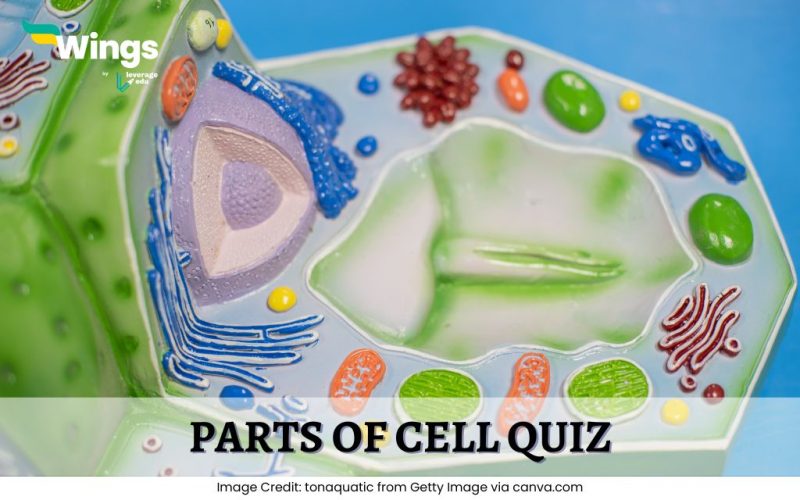Cells are the building blocks of life, and understanding their structure and function is essential for class 8 to 10 biology students. Whether you are learning about plant and animal cells or preparing for a cell structures and functions quiz, this parts of cell quiz with Answers will test your knowledge and help you revise key concepts.
This quiz is divided into sections based on difficulty level, covering topics like cellular structure and function, cell labelling, and the differences between plant and animal cells. Let’s see how well you know the parts of a cell!
This Blog Includes:
Parts of Cell Quiz – Basic Cell Structure and Functions
Let’s start with some easy questions to test your understanding of cell organelles and their functions.
1. What is the basic unit of life?
A) Atom
B) Molecule
C) Cell
D) Tissue
2. Which part of the cell controls all activities?
A) Nucleus
B) Mitochondria
C) Ribosome
D) Cytoplasm
3. The jelly-like substance inside the cell that holds organelles is called?
A) Nucleus
B) Cytoplasm
C) Golgi Apparatus
D) Cell Membrane
4. What is the function of the cell membrane?
A) Produces energy
B) Controls what enters and exits the cell
C) Stores genetic information
D) Breaks down waste
5. Which organelle is known as the ‘powerhouse of the cell’?
A) Ribosome
B) Mitochondria
C) Endoplasmic Reticulum
D) Chloroplast
6. What do ribosomes do?
A) Transport nutrients
B) Help in protein synthesis
C) Store water
D) Control cell activities
7. What structure is found only in plant cells and not in animal cells?
A) Nucleus
B) Chloroplast
C) Mitochondria
D) Cytoplasm
8. Which cell organelle helps in packaging and transporting proteins?
A) Ribosome
B) Golgi Apparatus
C) Lysosome
D) Nucleus
9. What is the role of lysosomes in a cell?
A) Produce energy
B) Digest and break down waste materials
C) Transport oxygen
D) Store DNA
10. What structure gives plant cells their rigid shape?
A) Cytoplasm
B) Cell Membrane
C) Cell Wall
D) Golgi Apparatus
Answer Key
| 1: C) Cell 2: A) Nucleus 3: B) Cytoplasm 4: B) Controls what enters and exits the cell 5: B) Mitochondria 6: B) Help in protein synthesis 7: B) Chloroplast 8: B) Golgi Apparatus 9: B) Digest and break down waste materials 10: C) Cell Wall |
Do You Know the Difference Between Prokaryotic and Eukaryotic Cells?
Cellular Structure and Function Quiz
Now, let’s move on to moderate-level questions that challenge your knowledge of cellular structures and their roles.
11. Which organelle stores genetic material (DNA)?
A) Golgi Apparatus
B) Nucleus
C) Ribosome
D) Cytoplasm
12. What is the function of the endoplasmic reticulum (ER)?
A) Produces energy
B) Stores water
C) Transports proteins and lipids
D) Breaks down waste
13. Which organelle is responsible for photosynthesis?
A) Mitochondria
B) Chloroplast
C) Golgi Apparatus
D) Ribosome
14. What is the role of vacuoles in plant cells?
A) Producing proteins
B) Storing nutrients, waste, and water
C) Controlling the cell
D) Breaking down sugars
15. What type of cell does not have a nucleus?
A) Animal cell
B) Plant cell
C) Prokaryotic cell
D) Eukaryotic cell
Answer Key
| 11: B) Nucleus 12: C) Transports proteins and lipids 13: B) Chloroplast 14: B) Storing nutrients, waste, and water 15: C) Prokaryotic cell |
Do You Know Lysosomes Are Known as Suicidal Bags of the Cell – Why?
Animal and Plant Cell Quiz
These are challenging questions to test your deep understanding of cell structures and their functions.
16. Which structure helps in cell division in animal cells but is absent in plant cells?
A) Mitochondria
B) Centrioles
C) Ribosomes
D) Cell Wall
17. What is the primary difference between smooth and rough endoplasmic reticulum?
A) The rough ER has ribosomes attached
B) The smooth ER produces DNA
C) The rough ER is found only in animal cells
D) The smooth ER digests food
18. Which process takes place in the mitochondria?
A) Protein synthesis
B) Cellular respiration
C) Photosynthesis
D) Digestion
19. What part of the cell modifies, sorts, and packages proteins?
A) Nucleus
B) Ribosome
C) Golgi Apparatus
D) Lysosome
20. Why do plant cells have larger vacuoles than animal cells?
A) To store more DNA
B) To support the plant by maintaining water pressure
C) To help in digestion
D) To produce oxygen
Answer Key
| 16: B) Centrioles 17: A) The rough ER has ribosomes attached 18: B) Cellular respiration 19: C) Golgi Apparatus 20: B) To support the plant by maintaining water pressure |
Do You Know Who Discovered the Cell and How?
Cell Labeling Quiz – Identify the Cell Parts
Can you label these cell structures in the following diagram? Try to identify them before checking the answers!
Q1. Which part of the cell contains DNA?
Q2. What is the outermost layer in plant cells?
Q3. What part of the cell makes proteins?
Q3. Where does photosynthesis take place?
Q4. Which organelle produces energy?
Check Your Answers!





FAQs about Parts of Cell
All cells share common components:
1. Cell Membrane: A protective barrier that regulates what enters and exits the cell.
2. Cytoplasm: A jelly-like substance where cell organelles reside.
3. Nucleus: The control centre containing genetic material (DNA).
3. Mitochondria: Known as the powerhouse, they generate energy for the cell.
4. Ribosomes: Sites of protein synthesis.
5. Endoplasmic Reticulum (ER): Involved in protein and lipid synthesis; rough ER has ribosomes, smooth ER does not.
6. Golgi Apparatus: Modifies, sorts, and packages proteins and lipids.
7. Lysosomes: Contain enzymes to digest waste materials.
8. Vacuoles: Storage sacs for nutrients, waste, and other substances; larger in plant cells.
9. Chloroplasts: Present in plant cells; sites of photosynthesis.
The nucleus serves as the control centre of the cell, housing genetic material (DNA) and coordinating activities like growth, metabolism, and reproduction.
Engage in interactive quizzes and worksheets focusing on cell structures and functions. These resources often include multiple-choice questions, labelling exercises, and matching activities to reinforce learning.
While both plant and animal cells share common organelles, key differences include:
1. Cell Wall: Present in plant cells, providing structure and support; absent in animal cells.
2. Chloroplasts: Present in plant cells for photosynthesis; absent in animal cells.
3. Vacuoles: Large central vacuole in plant cells for storage and maintaining turgor pressure; smaller, multiple vacuoles in animal cells.
Find more informative reads below!
This Parts of Cell Quiz with Answers covered cell labelling, cellular structures, and functions to help class 8 to 10 students master cell biology. Share your score in the comments and challenge your friends!

 One app for all your study abroad needs
One app for all your study abroad needs





















 45,000+ students trusted us with their dreams. Take the first step today!
45,000+ students trusted us with their dreams. Take the first step today!


